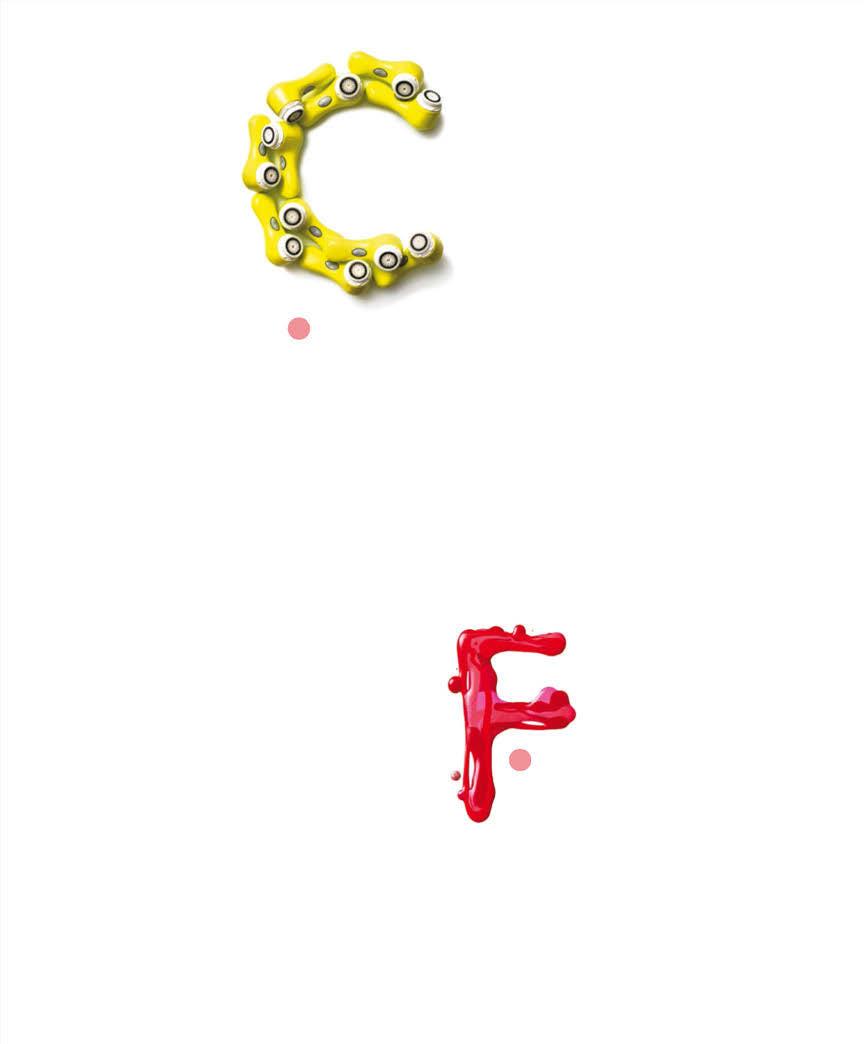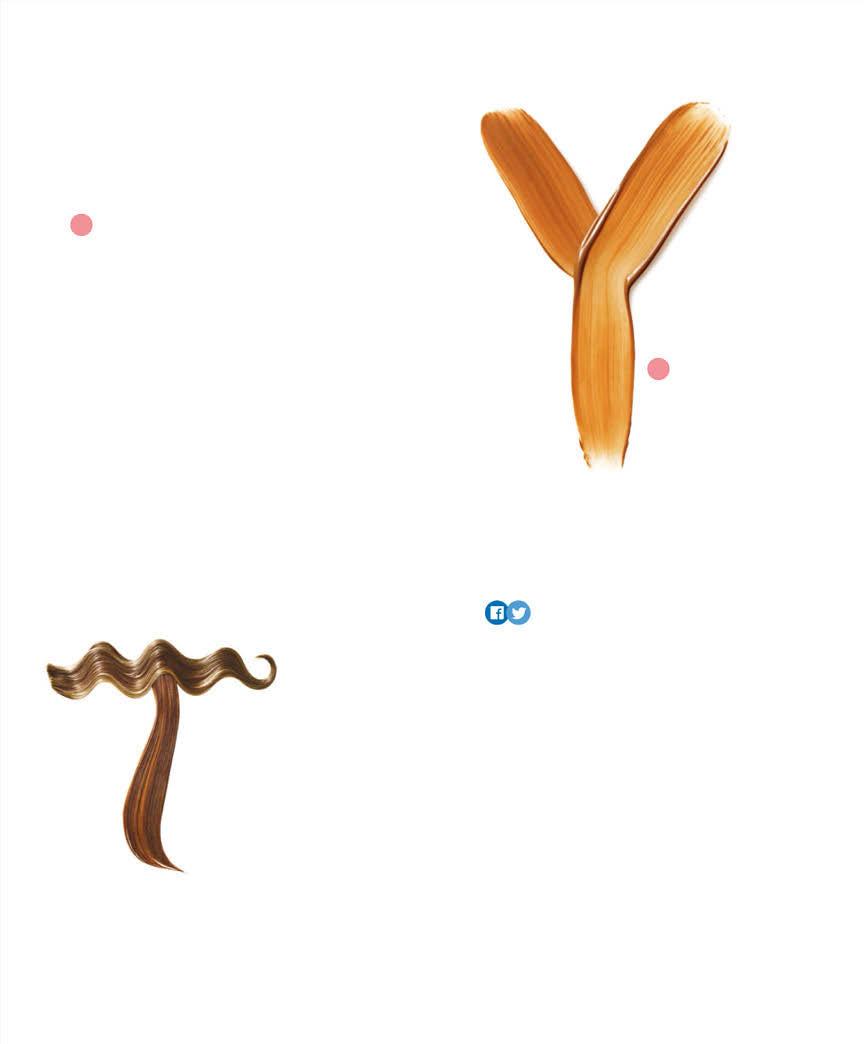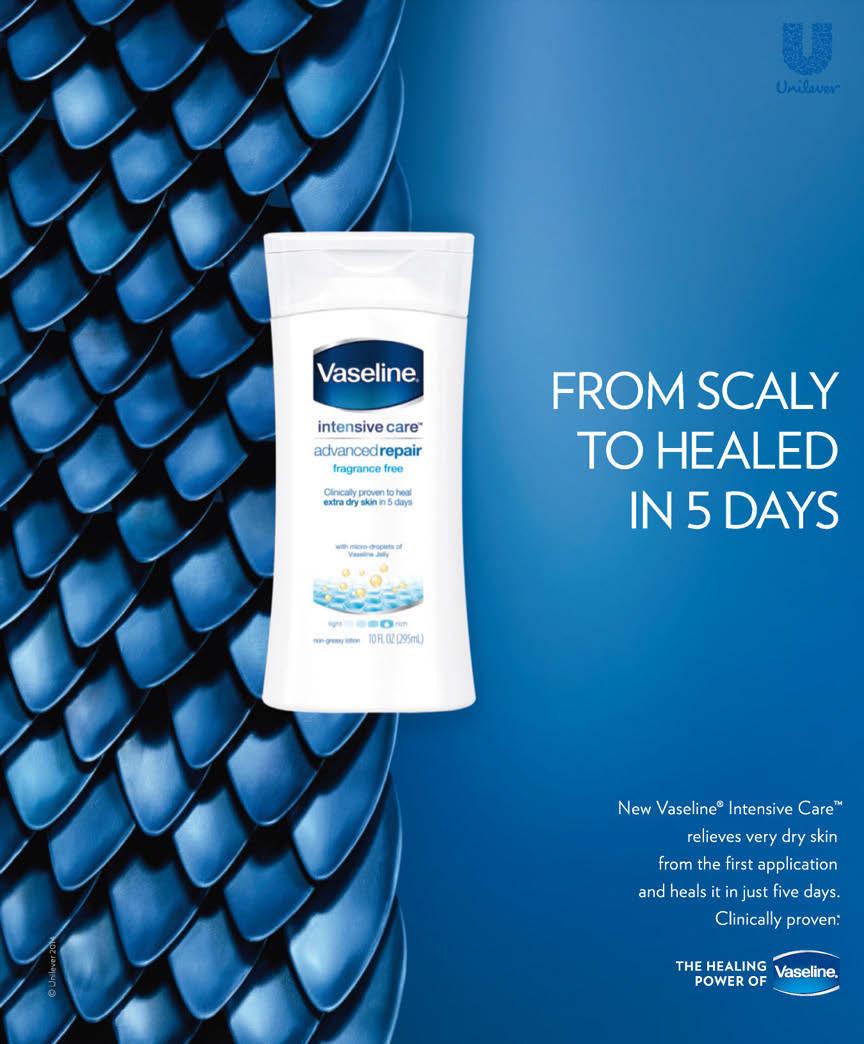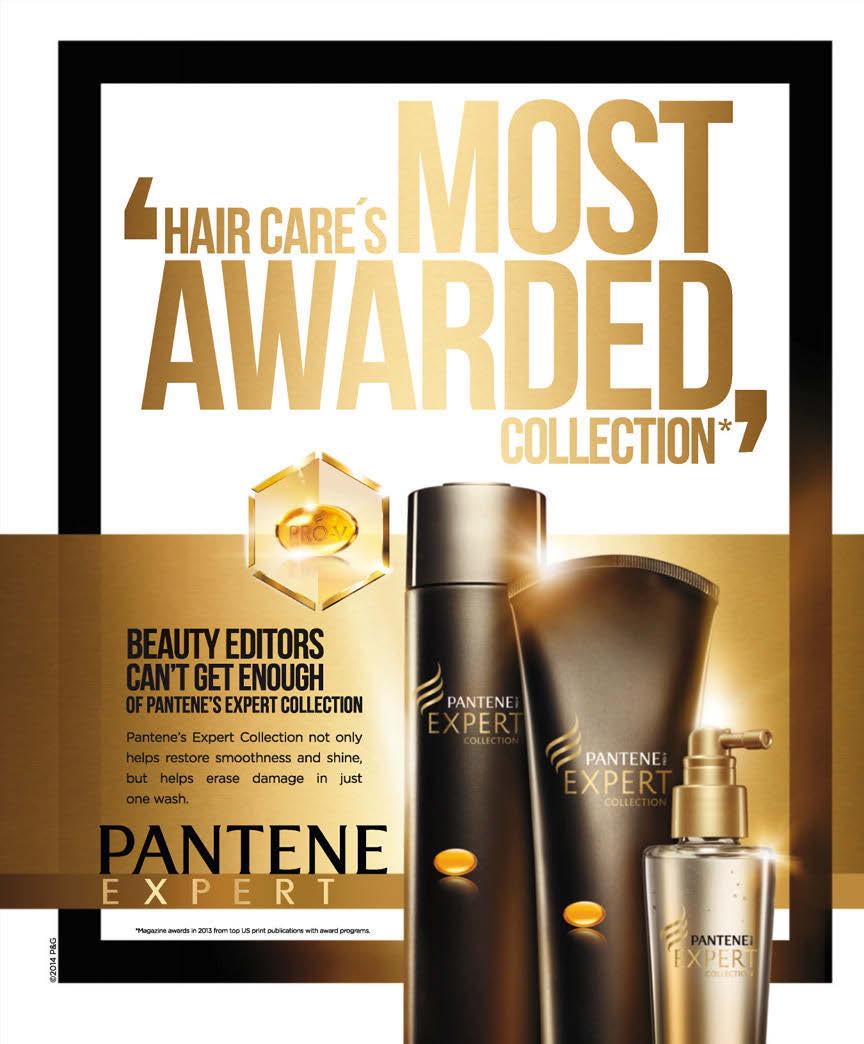
10 minute read
BREAKTHROUGHS
from RS - April 2015
15 YEARS OF BEAUTY BREAKTHROUGHS— AN A-TO-Z GUIDE
Written by Genevieve Monsma Photographs by Yasu+Junko
Advertisement

ANTIOXIDANTS IN SKIN CARE
In the early 2000s, antioxidants—such as vitamins C and E, idebenone, and green-tea extract—began cropping up in serums and creams. These substances neutralize free radicals (unstable molecules), which damage skin’s collagen and accelerate wrinkling. It was later discovered that some of these antioxidants (like vitamin C) even “help diminish dark spots,” says Elizabeth K. Hale, a New York City dermatologist, which is why most docs now consider them a cornerstone of any anti-aging regimen. Try: SkinCeuticals C E Ferulic ($157, skinceuticals.com) and Elizabeth Arden Prevage Anti-Aging Daily Serum ($162, elizabetharden.com).
BLOW-DRY BARS CLEANSING BRUSHES
Originally developed for in-office and in-spa treatments, the Clarisonic brush, which burst onto the skin-care scene 11 years ago, became so popular among professionals for its ability to provide deep cleaning and help smooth the surface of skin that the company decided to sell it to consumers. L’Oréal bought the company in 2011, and the cleansing devices are now distributed in 45 countries. Clarisonic’s best-seller? The Mia 2 ($149, clarisonic.com). New devices that offer similar results: the Clinique Sonic System Purifying Cleansing Brush ($90, clinique.com) and the Foreo Luna T-Sonic Cleansing System and Anti-Aging System ($199, ulta.com).
Five years ago, Los Angeles–based hairstylist Alli Webb joined forces with her brother and husband to create Drybar, today a nationwide chain of 40 blow-out–only boutiques that promise women good hair days for less than $50. With revenue growing from $8.7 million in 2011 to $40 million in 2013, Drybar also earned a slew of competitors. Some luxury salons (where a blow-dry can cost $75 and up) have opened lower-priced, blow-out–only outposts. “I’m so proud of the company we built,” says Webb, “and how we have been able to make women feel beautiful and confident.”
DOVE CAMPAIGN FOR REAL BEAUTY
In 2004 Dove debuted ads featuring real women, not models. Last year, on the 10th anniversary of the campaign, Unilever released the results of a new poll it says indicates a change in women’s attitudes toward their bodies—perhaps influenced by this more realistic imagery. In the poll, 62 percent of women reported that they now dictate what they consider to be beautiful, whereas 10 years ago only 23 percent said they felt this way. Progress.
E. MAX
Chew on this: E. Max, a cementable glass-ceramic material, allows cosmetic dentists to create very strong, thin veneers “without the need to shave down teeth prior to application,” says Michael Apa, an aesthetic dentist in New York City. Think beautiful, non–Bugs Bunny teeth.
GROWTH FACTORS
Vitamin A, found in Retin-A and overthe-counter retinol, has been an ingredient darling among dermatologists for decades for its ability to boost collagen production and make skin tighter and smoother. The downside? It can cause irritation. Hence the introduction of skin serums and moisturizers featuring growth factors (sometimes labeled as “epidermal growth factors” or “stemcell extracts”), which stimulate healthy cell production without stinging. They’re ideal for people with sensitive skin, but they don’t always come cheap. (Some potions will set you back hundreds of dollars.) Find growth factors in products by RéVive (reviveskincare. com), Lifeline Skin Care (lifelineskincare. com), and SkinMedica (skinmedica.com).
In 2006 consumer pressure (thank you, Internet) motivated a major nail-polish brand to remove from its formulas a “toxic trio” of potentially harmful ingredients: toluene, dibutyl phthalate (DBP), and formaldehyde. This eventually led many more companies to do the same and also become “five-free,” taking formaldehyde resin and camphor out of their products, too. This ushered in an age of increased transparency in cosmetic ingredients that made many companies, even those outside the beauty industry, rethink formulas. (See also: endocrine disrupters, like BPA, formerly found in baby bottles.) Try “five-free” Smith & Cult Nail Lacquers ($18 each, smithandcult.com).

HYALURONIC ACID
Craving instant gratification from your skin-care routine? Few ingredients provide it more effectively than the currently hot hyaluronic acid. “Hyaluronic acid improves the skin’s ability to retain moisture, making it appear plumper and less lined immediately,” says Kathleen Jennings, a beauty blogger and the founder of the BeautyNow app. Two hyaluronic acid–based moisturizers to try: Ling Dual Moisture Emulsion ($68, lingskincare.com) and Peter Thomas Roth Viz 1000 ($65, peterthomasroth.com).
INJECTABLES
Needle-based noninvasive procedures have exploded in popularity over the past 15 years. The first type, neuromodulators, which include Botox and Dysport, have been injected about 700 percent more than they were in 2000 and have “changed the face—pun intended— of cosmetic surgery, by being able to relax wrinkles without downtime,” says Paul Jarrod Frank, a cosmetic dermatologist in New York City. The second type, fillers, such as Restylane, Juvederm, and Belotero, which often contain hyaluronic acid, “allow us to literally fill in wrinkles and revolumize and lift skin on contact,” says Frank.
JERGENS NATUR AL GLOW DAILY MOISTURIZER
Points for being first— and still great after all these years! Introduced in 2005, this glowgetting lotion is applied like regular body moisturizer, but it produces a subtle tint within days, minus much mess. Why it works so well: It contains erythrulose and DHA, two tinting agents that work together to produce a more realistic and gradual color than traditional tanners, and it has an emollient base to ensure a smooth and even application. Fun fact: Jergens calculated that during year one in stores, an average of 11 bottles were sold per minute.
KERATIN TREATMENTS
For women who wake to a headful of frizz daily, “keratin treatments have been a lifesaver,” says Los Angeles celebrity stylist Marcus Francis. How they work: A keratin (protein) solution is applied to the hair, then sealed into strands with a flatiron. The result: hair that’s shinier and smoother, easier to blow-dry, and far less vulnerable to humidity. The effects typically last up to four months. While the treatment is not without detractors, due to its unproven but possible toxicity, many stylists maintain that for those who grapple with fierce frizz, there is no better remedy.
L ATISSE
Introduced in 2009, this lash-enhancing solution is “revolutionary in its ability to grow lashes and eyebrows,” says Francesca Fusco, a New York City dermatologist. The active ingredient, bimatoprost (first used to treat people with glaucoma or ocular hypertension), works by extending the growth cycle of lashes so that they stay put on the lids longer, creating a fuller effect. “What really excites me about this ingredient, though,” says Fusco, “is that ongoing clinical studies indicate that it’s promising for growing scalp hair, which would be a game changer for anyone with hair loss.”
MAKEUP THAT LASTS (AND LASTS)
“Volatile silicones and oils have given us greatly improved long-wear makeup,” says celebrity makeup artist Troy Surratt, who learned a lot about cosmetic chemistry while developing his recently launched line. These ingredients work by allowing for a smoother, less flaky application that leaves behind loads of glorious pigment. Find them in: Giorgio Armani Maestro Foundation ($64, giorgioarmanibeautyusa.com) and Maybelline New York Eye Studio Color Tattoo Cream Gel Shadow ($7, drugstores).

NAIL ART
You need look no further than Instagram for proof that nail art is a thing. (To wit: The nail industry took in $8.3 billion in 2013.) Better yet: You don’t even have to go to a salon to decorate your digits. The proliferation of such items as home gel-manicure kits (see page 182 for more info) and intricate nail decals have made being a polish Picasso a snap. Beginners can test the trend with a negative-space mani, in which a portion of each nail is left bare (for example, a half-moon above the cuticle) or by layering a glitter or polka-dotted topcoat over a creamy color.
ONLINE BEAUTY
Remember when you had to travel for access to small, innovative, but not widely available brands, like Eve Lom and It Cosmetics? Or find a makeup artist at the mall who could teach you how to wing eyeliner? Wow, how times have changed! Thanks to virtual emporiums, like sephora.com and ulta.com, and style sites, such as refinery29.com and Time Inc.’s own mimichatter. com, all the tools and tutorials you need are (literally) at your fingertips.
PEPTIDES
As with growth factors (see G, page 92), one benefit of skin-plumping peptides, another innovative anti-aging ingredient, is that, unlike topical vitamin A, they don’t seem to cause irritation. Among the first to use peptides in skin care was Olay, featuring it in its Regenerist line, which launched in 2007. While the Regenerist products have undergone updates, they still contain the original peptide complex, which is suitable for almost all. And Regenerist Micro-Sculpting Cream ($26 at drugstores) is still Olay’s best-selling product.
Q-TIPS PRECISION TIPS
The cotton swab has been a staple for makeup pros forever, but the fluffy tip made it challenging for the average Jane to wield for cosmetic purposes. In 2011, in response to women’s demand for a more makeupfriendly design, Q-Tips introduced a two-sided cottonswab stick with tapered ends ($3.50 for 170, at drugstores) that makes applying eyeliner, erasing lipstick bleeds, and cleaning up polish smudges a cinch.
ROOT TOUCH-UPS
Put this in the “Why didn’t we think of this sooner?” category. Women have embraced the influx of temporary root touch-up products, which—whether sprinkled, sprayed, or painted onto roots—conceal them until washed out. (Think concealer for hair.) Three that win top marks: TouchBack Instant Root Touch-Up ($30, ulta.com), Color Wow Root Cover Up ($34.50, colorwowhair. com), and Rita Hazan Root Concealer ($25, ritahazan.com).
SPRAY-ON BODY LOTION
After polling U.S. women and discovering that 80 million (what?) were not using body lotion daily, because they didn’t have the patience to wait for it to dry, Vaseline introduced Spray & Go Moisturizer ($7 at drugstores) in 2013, which goes on as a thin mist that dries in seconds. That same year, St. Ives launched Fresh Hydration lotions, with similar properties. A boon for busy women everywhere.

TEXTURIZING SPRAYS
Bumble and bumble’s Surf Spray ($27, bumbleand bumble.com) hit shores in 2001, giving even the landlocked an opportunity to score the effects of a day at the beach yearround. Bumble’s salt spray launched a whole category of texturizers that produce realistic-looking waves. New ones to try: Suave Professionals Sea Mineral Infusion Texturizing Sea Salt Spray ($5 at drugstores) and Redken Fashion Waves 07 Sea Salt Spray ($19, redken. com for salons).
VANIQA
For women with unwanted facial hair, the FDA’s approval of Vaniqa in 2000 was a godsend. This prescription cream blocks an enzyme needed for hair growth, thereby minimizing annoying facial fuzz.
WHITENING AT HOME
Whitening strips (we’re looking at you, Crest Whitestrips) are impregnated with a peroxide gel and stay on the teeth for approximately 20 minutes. “No muss, no fuss,” says Marc Lowenberg, a New York City cosmetic dentist. And at-home whitening technology just keeps getting better—meaning faster and less sensitivity inducing. Brands such as Supersmile, Go Smile, and GLO Science have gotten in on the act, and Crest has upgraded its offerings with no-slip strips in 2009 and a one-hour express kit in 2013.
XYLITOL
Studied in Finland in the 1970s for its dental benefits, xylitol, a sugar alcohol, finally made its way Stateside in the 2000s. “Used as a sweetener in items such as chewing gum, toothpaste, and mouth rinse, it prevents tooth decay by inhibiting the growth of the bacteria that causes cavities,” says dentist Michael Apa.
WHAT’S YOUR FAVORITE BEAUTY INNOVATION? Tweet us @realsimple or let us know on Facebook.
UVA-BLOCKING SUN PROTECTION
The early 2000s saw a major evolution in sunscreen formulations, as companies moved from making SPF-only products, which block just skin-burning UVB rays, to offering broad-spectrum protection. The term, created by the U.S. Food and Drug Administration (FDA) in 2011, means that a formula blocks both UVB and UVA rays (which contribute to cancer and aging) and has an SPF of 15 or higher. Two M.D.-approved broad-spectrum picks: La Roche-Posay Anthelios 60 Ultra-Light Sunscreen Fluid ($30, laroche-posay.us) and Neutrogena Ultra-Sheer Liquid Daily Sunscreen Broad Spectrum SPF 70 ($13 at drugstores).
YSL TOUCHE ÉCLAT FOR ALL WOMEN
In 1992 YSL introduced its best-selling, iconic Touche Éclat highlighting pen ($41, yslbeauty us.com). In 2012 the company offered six new shades to better meet the needs of the changing complexion of the United States, bringing the current total to 12. Now, if only everyone else would follow suit.
ZIT ZAPPERS
Bad news: The number of adult women suffering from acne in the United States is soaring. Good news: The skin-care industry has responded by creating adult-only acne-fighting options that are gentle to skin and also anti-aging. Some to try: Murad Anti-Aging Acne Regimen ($120, murad.com) and Dermalogica Medibac Clearing Skin Kit ($42, dermalogica.com). And Proactiv, the teen acne staple, has come out with Proactiv+, geared toward more “mature” skin types.












